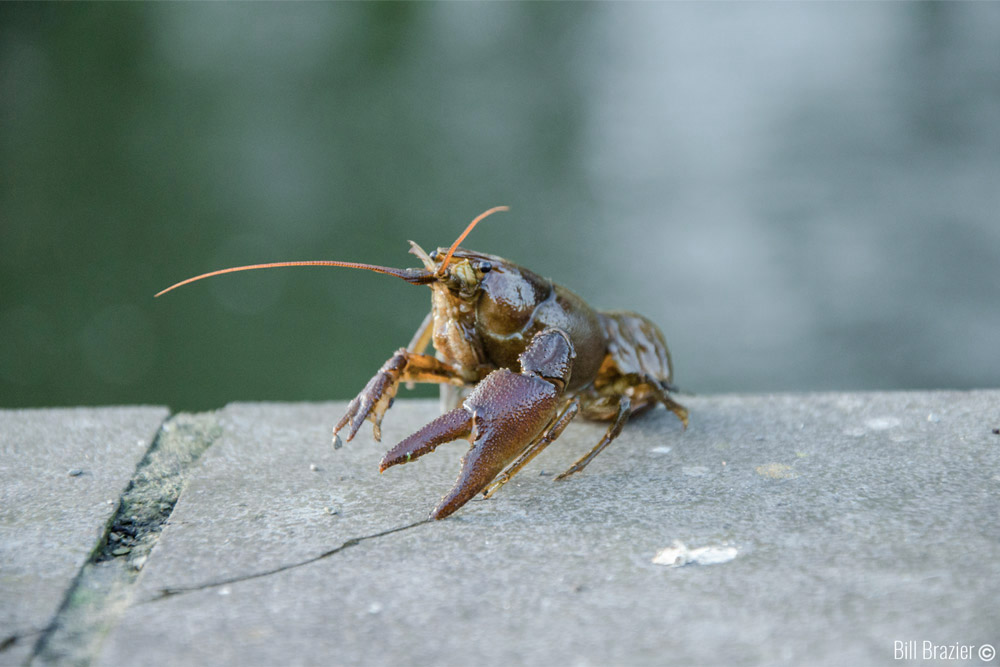
First crayfish plague outbreak of 2019
21st May 2019
An outbreak of crayfish plague, a fungal disease lethal to our native white-clawed crayfish (Austropotamobius pallipes), has been confirmed from the river Maigue near Adare in Co. Limerick. This is the first case reported in Irish water for 2019. DNA analysis by the Fish Health Unit at the Marine Institute has confirmed the presence of crayfish plague in the Maigue and further analyses are ongoing to establish if there may be any link between this and previous outbreaks on other Irish rivers.
Ireland was officially considered free from crayfish plague until 2015, when an isolated case was identified on the River Bruskey, Co. Cavan. In 2017 multiple large-scale outbreaks occurred on the rivers Suir, Barrow, Limerick Deel and Lorrha (Tipperary). A further three outbreaks were detected in 2018; on the Al River at Athlone ; the Blackwater near Aughentaine, Co. Tyrone and a new site on the River Barrow (upstream of previous outbreaks). Regulatory authorities have been heavily criticised for not doing more to prevent further spread of this deadly virus in Irish waters, with waterside signage and voluntary bans on water sports and angling at infected sites the only measures implemented. Public awareness campaigns on the issue have been deemed relatively ineffective by many stakeholders. This most recent outbreak on the River Maigue, a lower Shannon tributary, is yet another reminder of how fragile our aquatic ecosystems are and that all anglers and water users need to be extra vigilant in the cleaning (hot water), disinfecting and drying of their wet gear/equipment before moving between water bodies (please see our poster below). If you observe any peculiar crayfish behaviour then please contact the NPWS, Waterways Ireland, Inland Fisheries Ireland or this magazine immediately.
White-clawed crayfish, which are native to Irish waters, have suffered widespread declines through their European range in recent decades and are offered strict legal protection as an Annex II species under the EU Habitats Direction as a result. The species is also afforded protection under the Irish Wildlife Act (1976, amended 2000). Ireland represents one of the last remaining strongholds for the species. Crayfish are considered a vital part of healthy ecosystems where they occur, recycling organic matter and nutrients as well as providing a rich food source for a whole host of animals, including fish (read more on this here ).
Crayfish plague (Aphanomyces astaci) is a highly infectious fungus which causes 100% mortality in this declining native species. The fungus attaches to thin areas of outer shell (cuticle) as a spore and then grows through the tissues, leading to death in all cases within 2-3 weeks. The swimming spores then transmit directly from the infected or recently dead crayfish to other areas downstream. Spores are easily spread accidentally by anglers and other water users (e.g. canoes, kayaks, boats) through wet gear, and might also be spread inadvertently by water birds and other organisms. The fungus affects the normal vision of the crayfish and so it may be seen crawling around in broad daylight where it usually wouldn’t, although dead crayfish are the obvious sign of infection.
Crayfish plague originated in North American crayfish and it is their introduction to Europe which has caused many white-clawed populations to decline. To date no non-native crayfish have been discovered in Irish waters. Genotyping analysis by OIE reference laboratories in the UK and in Finland have shown there are at least three different genotypes of Aphanomyces astaci present in Ireland thus far. This genetic diversity of A. astaci suggests there have been at least three separate introductions of the disease into the country. This has highlighted an urgent need for a better understanding of the possible sources of the disease, its routes of transmission, and its current spread. The Maigue outbreak is yet another sombre reminder that all water users must employ stricter biosecurity measures to prevent further spread and ecological damage of invasive pathogens and species.
National Crayfish Plague Surveillance Programme In an effort to assess the prevalence of Aphanomyces astaci nationally and investigate the potential presence of non-native crayfish species which may have introduced the pathogen into Ireland; the National Crayfish Plague Surveillance Programme, jointly funded by National Parks & Wildlife Service (NPWS) & Marine Institute, was established in 2018. This surveillance programme uses the latest environmental (e)DNA methodologies to detect the presence of Aphanomyces astaci in water from selected sample points in all catchments/sub-catchments where white-clawed crayfish are known to be present (34 areas in total). The first phase of sampling for the surveillance programme ran from August 2018 until December 2018 to coincide with the crayfish moulting/reproduction season. Sample collection involves collecting water samples from 6 sampling sites on each of the 34 catchments. Water samples are then filtered on site and these filters are frozen for subsequent analysis using eDNA technology. Further details on the National Crayfish Plague Surveillance Programme can be can be requested from notification@marine.ie 
